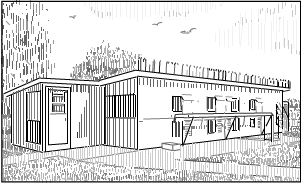
Building the Right Loft
Published:
Comments: 6 so far
The loft design, and resulting loft environment, directly affects the health of your birds. “Pristine Health” is the absolute key to performance both in the breeding loft and the race loft. Below are the most important factors in loft design
1. Clean, Fresh Air
Your loft absolutely must have a continuous supply of clean, fresh air. The ventilation must be good, but it must not have a draft. While this is essential, it can be rather difficult to find the correct balance between sufficient air and excess air. The area in which you live will directly affect this requirement. Air movement must be slow enough to avoid a draft but sufficient to provide a minimum of 10 air changes per hour. Following are a few ways air exchange may be accomplished:
- If your area normally has 5-10 mph breeze a roof top turbine vent will usually suffice.
- If you do not have sufficient wind to operate the turbine almost all of the time a power ventilation system may be necessary.
- Your birds generate heat and since heat (hot air) rises, a ceiling vent to the atmosphere may be sufficient.
An exhaustive discussion of air change methods is beyond the scope of these guidelines.
2. Provide enough space for each bird.
Given sufficient ventilation as described above, it is my opinion that an area of 1-square foot (1ft2) per bird is sufficient. An 8’ x 8’ loft will accommodate about 64 birds. There are certainly exceptions to this guideline. Placing more than 60 birds will require a more careful look at the ventilation. Fewer birds in a loft almost always results in better health. Overcrowding almost always results in health problems.
3. Maintain a Dry Acidic Environment
The Floor and Surface Beneath a wire type floor: Double T Loft is in West Texas. Our climate is very dry (low humidity) and there is almost always a 5-15 mph wind. We often have 15-30 mph winds. In the summers it is very hot (100F+) and dry. In the winter the temperature varies greatly. It freezes often, but the day time temperatures are usually above freezing. Rainfall average is 9-11 inches per year….which is obviously very low. That said, we do often have enough humidity and rain that we must ensure the floor or area under the loft remains dry. It must not only remain dry, but it must also be slightly acidic.
Why must it be acidic? The bacteria that encourage e-coli, paratyphoid and other intestinal infections and problems thrive in a basic environment. It does not thrive in an acidic environment. Obviously to help avoid intestinal issues and encourage pristine health we must maintain an acidic environment.
How do we maintain an acidic environment?
Lime is a “base” and is not a good floor dressing!
Floor dressings designed specifically for pigeon lofts are typically acidic.
Clorox is a “base” and while is works very well to disinfect out water containers, providing water containing Clorox is not a good long term practice.
Vinegar is an “acid”. Apple cider vinegar is a great additive to your birds’ drinking water.
4. Clean, Fresh Water
The water system must supply clean, fresh water that is not accessible to mice or other crawling “critters”. Many fanciers “drop the ball” and fail to provide a continuous supply of clean, fresh drinking water for their birds. It is quite common to find dirty water in the lofts. Obviously you would not drink water that contained any trace of fecal matter. We must follow the same principle for our birds. Clean water is absolutely essential for pristine health! Water must be placed in a location that provides maximum prevention of contamination of the drinking water. The containers must be cleaned and disinfected and the area must be disinfected and clean. Don’t allow this to slip….the water must be clean. Get it off the floor and away from large traffic areas to ensure it stays clean, fresh and out of the sun.
5. Accessible and Clean Food
Feed must be clean and placed in such a manner that is it kept clean and each bird must have sufficient space so that all birds can access the food at the same time. Feed should be provided in a way that each bird in the loft is able to access the feed at the same time. An effort to protect the feed from pigeon droppings and other foreign matter getting into the feeder. An open feeder is not the best option. If feed is placed before the birds at all times, every effort should be made to keep the feed clean. Additionally, the feeders need to be located to avoid rain water wetting the feed.
6. Keep Grit and minerals off floor
These items should be off the floor and placed in an area to help ensure the no droppings enter the supplement containers. These must also be kept dry. Since these supplements are not consumed in large quantities and since many birds do not typically consume these supplements at the same time, smaller crocks and containers are a sufficient size.
7. If birds are not allowed out of the loft, provide an aviary
If you have birds that are not allowed out of the loft, aviaries should be provided to allow the birds to get into the fresh air and sunlight. This will also allow the birds to have baths. The aviary can be covered, uncovered, completely open, or partially open. The aviary must be tight and not allow wild birds or critters to enter. It must also be designed to prevent critters from coming underneath the aviary bottom and pulling legs off the birds. External access to the aviary is necessary and they should be kept locked.
8. Loft Lighting
The loft should have sufficient light during the day so that the bird can move around freely. If the darkening system is used, there should still be enough dim light to move about. If a darkening system is not used one may adjust the amount of light to suit your self. It is my opinion that the birds are a little more relaxed and comfortable in a loft that is not “super” bright. Rather a little shading, like shade cloth over the wire front, is my preference.
Your loft should have both electrical outlets and lights. Lights are essential for obvious reasons. You will need to be in the loft during dark times on a frequent basis. If you use a light system for young birds you will need the lights. My suggestion for the YB loft is to use an outlet on a switch and plug the light into the outlet….this allows the use of a timer for the YB light system.
9. Face Loft Southeast
I prefer the loft have morning sun rather than afternoon sun. Given winter storms are typically from the north, I prefer the loft not face north. If the loft faces directly south there is not enough direct sun that enters the loft on a year-round basis. All that said, the result is for the loft to face east or southeast. In West Texas many of our worst rain storms come from the east so I prefer the loft face southeast. That may or may not work for your area, but those I have spoken with prefer facing the southeast.
10. Loft must be Well Sealed
The ability for rodents to enter the loft and contaminate the feed presents a very large problem. Rodent urine and droppings definitely can introduce e-coli and bacterial infections to the birds via feeders and feed bins. If mice can get in, snakes can also get in. Snakes present an additional problem. Snakes will eat eggs and small young birds. They will kill older birds and be unable to eat them. In areas when poisonous snakes are present, they introduce a significant problem to the fancier.
Additionally, wild birds, especially sparrows should be kept out of the loft. This is often difficult as they will go through the traps and enjoy the food in the loft.
If you are a cat lover you can introduce a cat into the loft to live there. That will typically prevent rodents and snakes from causing problems. If you want more information about the introduction of a cat (aka: “mouse catcher”), please contact me.
This list of guidelines is certainly not exhaustive. If you have questions I will be pleased to answer them. Please contact me at the following email: tom@doubletlofts.com

6 Responses to Building the Right Loft